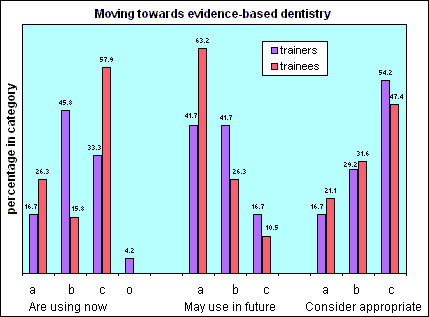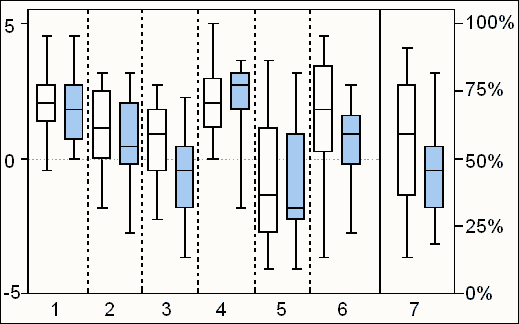Ths peer reviewed article was first published in the journal Tuith Online
GGeneral dental practitioners view on the pursuit and practice of evidence-based dentistry: The results of a questionnaire
This page is in summary format. If you would like, you can also read the full report.
Summary format
- Survey into the views of trainers and trainees in general dental practice carried out as a pilot study.
- Not necessarily representative of opinions of majority of GDPs but good insight into the some of the barriers standing in the way of a more complete adoption of evidence-based practice into primary care dentistry.
- Highlighted differences and similarities between the understanding or perceived understanding of two groups at different stages of their careers.
Introduction
- Evidence-based medicine, including evidence-based dentistry, is a process of life-long, problem-based learning.
- There are ethical and legal requirements for practitioners to provide effective evidence-based treatment, rather than outdated, experimental, or otherwise less effective non-evidence-based treatment.
- The bulk of the expenditure and clinical activity is undertaken by general dental practitioners (GDP), however, the majority of research into clinical dentistry is undertaken by dental schools with some investigations being undertaken within the community dental service.
- The findings of this research activity are presented primarily in peer reviewed journals in a format which busy GDPs can find unhelpful and, possibly, confusing.
- Healthcare providers, researchers, and policy makers are inundated with unmanageable amounts of information from other sources.
Subjects and Methods
- Survey questionnaires were handed out on two separate occasions to target two distinct populations of primary care dentists; the first being persons responsible for providing vocational training and the second those undergoing training.
- Respondents were provided with a definition for evidence-based dentistry based on a published definition.
"the conscientious, explicit, and judicious use of current best evidence in making decisions about the care of individual patients. Its practice means integrating individual clinical expertise with the best available external clinical evidence from systematic research."
- Series of questions posed.
Results
- 43 questionnaires were completed in total, 24 by the trainer group and 19 by the trainee group, though some respondents did not answer all questions.
Attitudes towards evidence-based dentistry.
- The replies of the respondents to the questions concerning their attitude towards the value and practice of evidence-based dentistry are shown in figure 1.
Figure 1 Respondents attitudes towards evidence-based dentistry
(lanes 1-6: 0 to 5, positive attitude; 0 to -5, negative attitude; lane
7 is percentage. Light blue boxes represent trainees).
Questions
- How would you describe your attitude towards the current position
of evidence-based dentistry?
- How would you describe the attitude of most of your GDP colleagues
towards evidence-based dentistry?
- How useful are research findings in your day to day management of
patients?
- The adoption of EBD, however worthwhile as an ideal, places another
demand on already overloaded GDPs
- Practising evidence-based dentistry improves patient care?
- Evidence-based dentistry is of limited value in general dental practice
because much of primary care lacks a scientific base.
- What percentage of your clinical practice do you feel is currently
evidence based?
- Most respondents had positive attitudes towards current evidence-based dentistry.
- Many claimed to be more positive than average.
- Less sure on how much benefit would accrue from greater adoption of research findings.
- Estimated 14% to 90% of practice evidence-based (trainers mean 56%, trainees 45%).
- Most felt that primary care was not scientifically based and that EBD would place extra demands on their time.
- Little differences between opinons of the two groups.
Routes towards evidenc-based practice
- 16.7% and 21.1% (trainers and trainees) favoured identifying and appraising the primary literature or systematic reviews themselves.
- 54.2% and 47.4% prefered the idea of using evidence-based practice guidelines developed by others.
- 45.8% and 15.8% said they were using evidence-based summaries in day-to-day practice.
- In contrast, 29.2% and 31.6% thought these were an appropriate aid to practice.
These and other results are shown in figure 2.
Figure 2 Moving from opinon-based to evidence-based practice. Which route is most appropriate?

Key:
- by learning the skills of evidence-based healthcare (i.e. to identify and appraise the primary literature or systematic reviews oneself)
- by seeking and applying evidence-based summaries which give the clinical 'bottom line' or
- by using evidence-based practice guidelines or protocols developed by colleagues for use by others.
Those respondents who ticked two options were assigned to the most self-reliant option (i.e. c>b>a). 'o' indicates question not answered.
Accessing the evidence
Trainers
- The majority of trainers (18/24) had not recently used a bibliographic database such as Medline for literature searching.
- Of those who had, the topics of interest were infectious prophylaxis for endocarditis, periodontics, oral medicine, dental pain, Bell's Palsy, adhesive dentistry, and Hepatitis C.
- Only 1 in 8 had received training in literature searching strategies. 41.6% reported formal training in critical appraisal and 17.4% had attended other related courses, for example as part of vocational training.
- There was a relatively low awareness of review publications and relevant databases with only 25% reporting having read the journal "Evidence-Based Dentistry" and half this number having consulted the "Effective Health Care Bulletins".
- Only 6 respondents had recently used Medline.
Trainees
- Most of the trainees had recently used Medline during their training, with frequencies varying between slight use and regular use.
- Topics of interest included endodontics, periodontics, oral cancer, mouthguards, toothwear, and composite - glass ionomer comparisons.
- A third had received formal training in information searching and most in critical appraisal.
Facilitating the practice of evidence-based dentistry
- Suggestions included; activities involving discussion between all members of the dental team, including journal clubs and other literature reviewing activities, backed up by clinical audit, payment of fees for attending courses and for adopting new protocols, and concise, reader friendly guidelines.
- More pre-filtering of information called for.
- GDPs need more training to acquire new skills and encouragement to change 'old habits'.
- Ethical issues, patients' views, and need for consistency were other areas that need to be addressed to further improvements in the quality of care for patients.
Understanding technical terms in the literature
- Overall, very few respondents had a great deal of confidence in their understanding of any item on a list terms: certainly not enough to explain their use to others.
- The trainers and the trainees were quite similar in their estimations of their abilities and knowledge.
- One item where they did apparently differ was that only 16.6% of trainers had some or good understanding of confidence intervals compared to a self-estimated 47.4% of those being trained. (figure 3)
Figure 3

Click on image to view larger size
Discussion
The results of these questionnires are discussed in the full report.
Conclusion
- This pilot study gave good insight into the some of the barriers standing in the way of a more complete adoption of evidence-based practice into primary care dentistry.
- Differences and similarities were highlighted between the understanding or perceived understanding of two groups at different stages of their careers.
- The major barriers are perceived to be mainly those of time and resources.
- Dentists could not afford to devote time to extracting information from academic literature.
- There was relatively little knowledge of review publications and this may indicate that such publications may not be reaching this audience.
- Technical terms are poorly understood.
Reviewers
- Marie Pitkethly, Tayside Centre for General Practice, Dundee.
- Maggie Leggate, Dental Postgraduate Centre, Dundee.
Authors
- Brian C. Bonner, Research Support Fellow, Dental Health Services Research Unit
- Jan E. Clarkson, SCPMDE Senior Lecturer, Dental Health Services Research Unit
- Wendy McCombes, Regional General Practice Vocational Training Adviser
|



